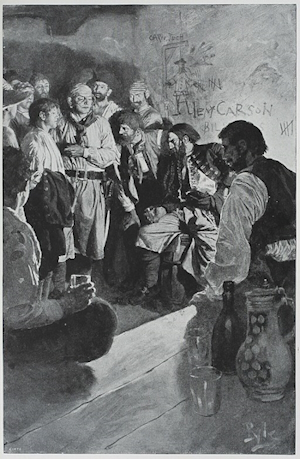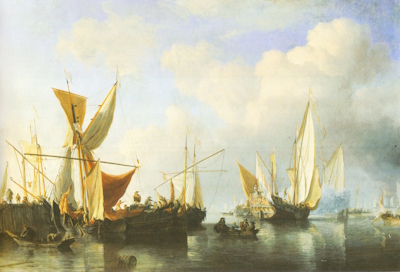 The term quartermaster can be confusing, as the meaning can vary according to the context. The quartermaster on a naval vessel stood watch next to the helmsman and was responsible for maintaining the ship’s course, whereas in armies on land, a quartermaster was an officer who supervised logistics and requisitions, managed the stores and barracks, and distributed supplies and provisions. A pirate quartermaster had numerous, less well defined responsibilities, which could vary from ship to ship.
The term quartermaster can be confusing, as the meaning can vary according to the context. The quartermaster on a naval vessel stood watch next to the helmsman and was responsible for maintaining the ship’s course, whereas in armies on land, a quartermaster was an officer who supervised logistics and requisitions, managed the stores and barracks, and distributed supplies and provisions. A pirate quartermaster had numerous, less well defined responsibilities, which could vary from ship to ship.
The term quartermaster might derive from the title of a German royal official, the Quartiermeister. This term meant ‘master of quarters’, where ‘quarters’ refers to lodgings or accommodation. Alternatively, it could have been derived from ‘master of the quarterdeck’, the deck where the quartermaster was positioned on a naval vessel. Both terms might have developed independently in the navy and army. The French and Dutch naval titles were quartier-maître and kwartier-meester.


 Pirates made use of many types of ships, in particular smaller versatile vessels which could navigate the shallow waters and shoals characteristic of the Caribbean. Bigger was not necessarily better as larger ships with their complex rigging and large area of canvas were more difficult to sail. Although the term ‘ship’ strictly applied to three-masted, fully rigged vessels, the word was often applied to sloops and brigantines at the time. The names applied to seafaring vessels have changed over time, but here the terms here are those used during the Golden Age of Piracy. During this period, ships were often defined by their type of rigging rather than the shape of their hull or number of masts. A lot of ships possessed at least some oars in the early 18th century, whether brigantines, sloops, or frigate-built ships, allowing for more versatility, especially when there was no wind. At the time, the term man-o’-war could be applied to any vessel of any size fitted for war.
Pirates made use of many types of ships, in particular smaller versatile vessels which could navigate the shallow waters and shoals characteristic of the Caribbean. Bigger was not necessarily better as larger ships with their complex rigging and large area of canvas were more difficult to sail. Although the term ‘ship’ strictly applied to three-masted, fully rigged vessels, the word was often applied to sloops and brigantines at the time. The names applied to seafaring vessels have changed over time, but here the terms here are those used during the Golden Age of Piracy. During this period, ships were often defined by their type of rigging rather than the shape of their hull or number of masts. A lot of ships possessed at least some oars in the early 18th century, whether brigantines, sloops, or frigate-built ships, allowing for more versatility, especially when there was no wind. At the time, the term man-o’-war could be applied to any vessel of any size fitted for war. What did pirates eat? Anything they could get their hands on. Although fresh produce was scarce on long sea voyages, pirates didn’t usually spend as long at sea as the average sailor on a naval ship or merchantman. They would normally sail out from their base to seize there pray and return with their booty, where they could purchase fresh provisions. When no friendly port was available, food could be obtained by foraging on one of the many islands or even from plundering. After the fall of the pirate nest Nassau in 1718 and with the increasing pressure on pirates from the Royal Navy, their bases no longer existed and the sea rovers probably had to go for longer periods without fresh food.
What did pirates eat? Anything they could get their hands on. Although fresh produce was scarce on long sea voyages, pirates didn’t usually spend as long at sea as the average sailor on a naval ship or merchantman. They would normally sail out from their base to seize there pray and return with their booty, where they could purchase fresh provisions. When no friendly port was available, food could be obtained by foraging on one of the many islands or even from plundering. After the fall of the pirate nest Nassau in 1718 and with the increasing pressure on pirates from the Royal Navy, their bases no longer existed and the sea rovers probably had to go for longer periods without fresh food.